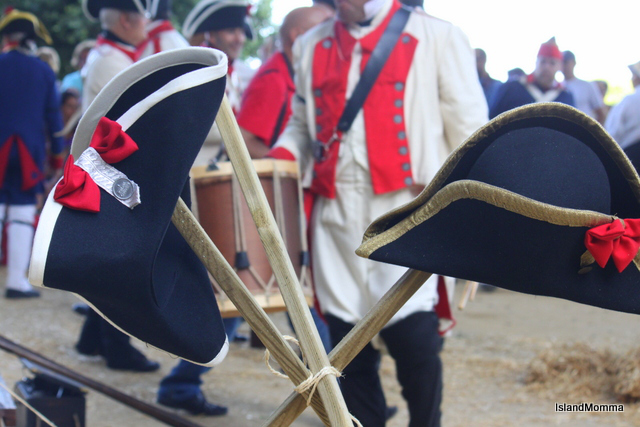Many will have read stories and been taught about one of the UK’s national heroes, Horatio Nelson; that brave son of Norfolk who taught the Spanish a thing or two during his famous battles, his “mesmerising personality”, complicated love scandal and heroic death. The stories surrounding Nelson are, of course, based upon the British point of view. Are they true? How about looking at Nelson from the Spanish and Canarian perspective?
About 220 years ago, Admiral Nelson of the British Royal Navy decided to attack Santa Cruz in Tenerife to help himself to some gold and silver collected by Spanish galleons from the Americas, but was humiliatingly and satisfyingly defeated by the local residents. I guess this part wasn’t stressed too strongly during school history lessons, was it?
The residents of Santa Cruz de Tenerife have long memories of their history and proudly re-enact an historical event each year on 25 July that reminds everyone of the Battle of Santa Cruz in 1797. This re-enactment of this battle has taken place for many years in a variety of formats. Why was this battle so important to the people of Tenerife?
In 1797 the British Royal Navy decided to attack the port of Cadiz in Southern Spain, but Spanish warships drove the British away. By chance, the British Navy heard that Spanish treasure convoys from America arrived regularly at Santa Cruz in Tenerife, and sent a flotilla of ships under the command of the recently promoted Admiral Nelson.
This attack force had 4000 men, nine ships and 400 guns, but the military on Tenerife led by Lieutenant General Gutierrez only had 91 guns and a mixture of 1700 militia and sailors. This looked to be an overwhelming attack force with insufficient military to defend the port of Santa Cruz.
Things did not work out as planned for Nelson, as the Tenerife commander was more experienced and particularly clever in managing his soldiers. Several British ships were sunk and many sailors were killed in this failed attack. This was also the battle when Admiral Nelson was shot in his right arm, and he had to be taken back to his ship where the ship surgeon amputated most of this arm with the help of some opium to lessen the pain in the middle of the battle.
Many British militias became trapped on the shores of Tenerife with no escape possible. Although 30 Tenerife residents were killed and 40 were injured; 250 British militia were killed and 128 were wounded.
The British asked for a truce and agreed to withdraw with an undertaking to do no further damage to the town or to make any more attacks on Tenerife or the Canary Islands. This was agreed by Lieutenant General Gutierrez, who also allowed the British to leave with their arms, but perhaps not Nelson.
However, Admiral Nelson had lost so many ships that he did not have capacity to take all his militia back home, so the Tenerife General lent Nelson two Spanish schooners. This was a huge embarrassment for the British Navy and a resounding success for the militia of Tenerife in protecting their island. I doubt that much of this story has found its way into the National Curriculum syllabus, as it really does not show the British in a particularly good light.
There are also some interesting facts that are linked to the Battle of Santa Cruz, such as what happened to Nelson’s right arm after it was amputated? It was thought that the arm was thrown overboard after the on-board operation, as was usual during this period, but it seems that some keen-eyed Tenerife resident found this floating in the sea or washed ashore, and eventually Nelson’s arm ended up interred within the altar of the Cathedral of Las Palmas de Gran Canaria.
This story has been challenged, but it has not been denied either! Also, the honourable withdrawal and truce led to a courteous exchange of letters between Nelson and Gutierrez. Later, Nelson sent a large cheese to Gutierrez as a token of his gratitude, which was never eaten and is still on display at the Spanish Army Museum in Toledo in Peninsular Spain. Maybe the good General did not trust the British to send a cheese that wasn’t poisoned?
No doubt the British will hope that people will forget the Battle of Santa Cruz de Tenerife in 1797 and the humiliating defeat that the brave people of Tenerife achieved over the British Navy. However, the residents of Santa Cruz in Tenerife are determined never to forget this momentous day in their history. Many wear faithful reproductions of uniforms and weapons of this historical period in all its detail of the battle in July.
Many might think that Tenerife residents would hate Admiral Nelson as he had planned to rob them and destroy their homes, but actually he became admired as he stuck to his word and the British Navy never returned to attack the Canary Islands. Indeed, there is one street in Santa Cruz that is named ‘Avenida Horacio Nelson’, which says a great deal about the island’s capacity for forgiveness, or is it amusement?
Anyway, the Canary Islands still have Nelson’s arm in their possession, or maybe not, but it definitely has a smelly cheese as a result of this battle from long ago.
If you enjoyed this article, take a look at my websites: http://barriemahoney.com and http://thecanaryislander.com or read my latest book, ‘Letters from the Canary Islands’ and Spain’ (ISBN: 9780995602731). Available in paperback from Amazon, Waterstones and all good bookshops, as well as Kindle editions.
Join me on Facebook: @barrie.mahoney
© Barrie Mahoney





